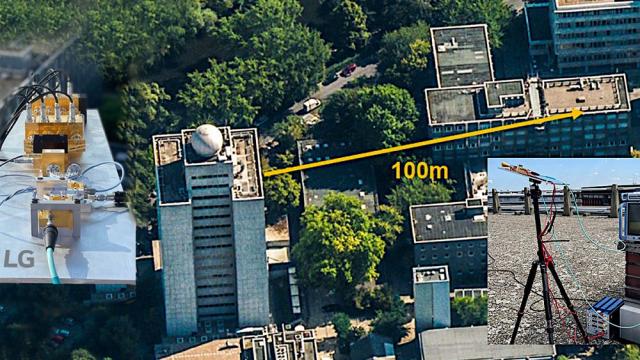If you’ve wondered why you’ve been hearing about 5G for years but the actual rollout has been glacially slow, looking at the development of 6G (the next-next-generation wireless standard) should provide some answers. Today LG announced a new milestone with a record-setting 6G wireless data transmission. Are we talking across an entire city? Nope, try the building next door.
Back in June, it was Samsung that touted a new record for 6G wireless transmissions using hardware — a 140GHz transmitter — first developed at the University of California, Santa Barbara, back in 2017. The researchers successfully transmitted data at a rate of around 775 MB every second (6.2 Gbps) across a distance of about 15.24 m. The speed record before that, set by Nokia and Turkey’s Turk Telekom back in March, had topped out at around 4.5 Gbps.
With today’s announcement, LG Electronics, which has been working with the European research lab Fraunhofer-Gesellschaft, didn’t go into details about how much data was transmitted, but we know 6G is going to be blazing fast. That’s a given because 6G signals will exist in the currently unused terahertz spectrum, past 100 GHz (5G signals exist in a frequency range up to 40 GHz) and across a wider bandwidth of frequencies so there will be less wireless traffic to deal with.
The problem with the THz frequencies that 6G will use is that they currently have a very limited range, and tend to lose a lot of power when passing through antennas used for transmission and reception. Instead of simply adding even more cellular towers across the country to bridge the gaps, the ideal solution is to find ways to increase the distance of 6G broadcasts.
LG worked with the Fraunhofer Heinrich Hertz Institute and the Fraunhofer Institute for Applied Solid State Physics to develop a new power amplifier as well as an adaptive beamforming technology that’s used to better target and direct wireless signals. On August 13, the technology was used to successfully transmit a 6G signal outside in the 155 to 175 GHz range from the Fraunhofer HHI building to the Berlin Institute of Technology in Germany across a distance of 100 metres.
That might not seem like a mind-blowing record given the two buildings are basically right next door to each other, but it’s an important step to making the technologies that will power 6G work in a practical environment, and not just inside a tightly controlled lab environment. It’s also important to remember that the 6G standard hasn’t even been finalised yet, that won’t happen until 2025 at the earliest, with the technology possibly rolling out to consumers by 2029 or 2030, which is an optimistic estimate given how the 5G rollout is still going. But it promises to bring us one step closer to ubiquitous wireless data connections everywhere and finally saying goodbye to ISPs.
